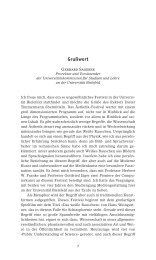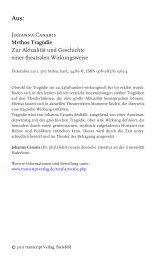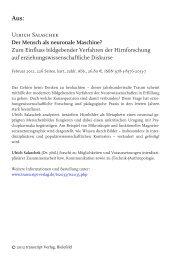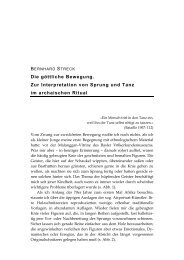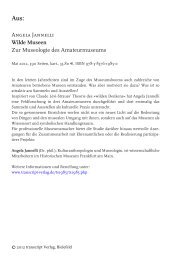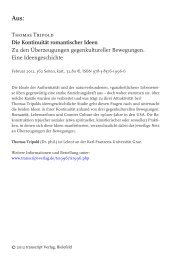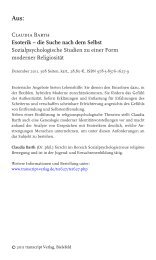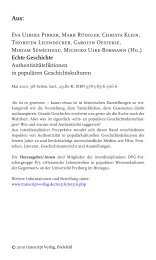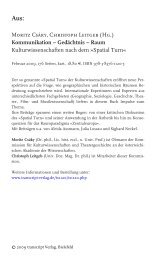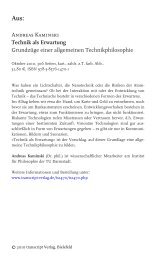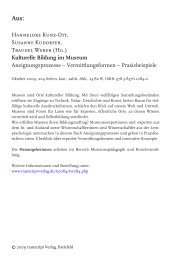Julia Straub (ed.) Paradoxes of Authenticity Studies on a Critical ...
Julia Straub (ed.) Paradoxes of Authenticity Studies on a Critical ...
Julia Straub (ed.) Paradoxes of Authenticity Studies on a Critical ...
You also want an ePaper? Increase the reach of your titles
YUMPU automatically turns print PDFs into web optimized ePapers that Google loves.
20 | JULIA STRAUB<br />
at the heart <str<strong>on</strong>g>of</str<strong>on</strong>g> Western debates <strong>on</strong> subjectivity, affects the search <str<strong>on</strong>g>of</str<strong>on</strong>g><br />
the modern self “in a kaleidoscope <str<strong>on</strong>g>of</str<strong>on</strong>g> attribut<str<strong>on</strong>g>ed</str<strong>on</strong>g> and self-chosen roles”<br />
(40). In the sec<strong>on</strong>d part <str<strong>on</strong>g>of</str<strong>on</strong>g> her essay, setting <str<strong>on</strong>g>of</str<strong>on</strong>g>f from her two case<br />
studies, Binjamin Wilkomirski’s fake memoir Fragments and the case<br />
<str<strong>on</strong>g>of</str<strong>on</strong>g> an Englishman-g<strong>on</strong>e-native, the Indian Grey Owl, Assmann unfolds<br />
the central paradoxes that affect c<strong>on</strong>temporary debates <strong>on</strong> authenticity<br />
and identity, and the implicati<strong>on</strong>s <str<strong>on</strong>g>of</str<strong>on</strong>g> literature in processes <str<strong>on</strong>g>of</str<strong>on</strong>g> selfauthenticati<strong>on</strong>.<br />
In her essay <strong>on</strong> “The Ambiguousness <str<strong>on</strong>g>of</str<strong>on</strong>g> the Authentic,” Susanne<br />
Knaller discusses the status <str<strong>on</strong>g>of</str<strong>on</strong>g> authenticity in art theory and twentiethcentury<br />
art as a c<strong>on</strong>cept situat<str<strong>on</strong>g>ed</str<strong>on</strong>g> between referentiality and autology.<br />
Referring to discussi<strong>on</strong>s <str<strong>on</strong>g>of</str<strong>on</strong>g> falsificati<strong>on</strong>, she suggests that copies <str<strong>on</strong>g>of</str<strong>on</strong>g><br />
works <str<strong>on</strong>g>of</str<strong>on</strong>g> art and other forms <str<strong>on</strong>g>of</str<strong>on</strong>g> forgery must make us not <strong>on</strong>ly rethink<br />
the <strong>on</strong>tological distincti<strong>on</strong> between ‘authentic’ and ‘inauthentic,’ but<br />
also that <str<strong>on</strong>g>of</str<strong>on</strong>g> ‘art’ versus ‘n<strong>on</strong>-art.’ The copy ne<str<strong>on</strong>g>ed</str<strong>on</strong>g>s to be seen as a complementary<br />
category to the more establish<str<strong>on</strong>g>ed</str<strong>on</strong>g> c<strong>on</strong>cepts <str<strong>on</strong>g>of</str<strong>on</strong>g> ‘the original’<br />
or ‘the authentic.’ It has a productivity <str<strong>on</strong>g>of</str<strong>on</strong>g> its own which ne<str<strong>on</strong>g>ed</str<strong>on</strong>g>s to be<br />
acknowl<str<strong>on</strong>g>ed</str<strong>on</strong>g>g<str<strong>on</strong>g>ed</str<strong>on</strong>g>. Looking at photography and documentary art forms<br />
emerging towards the end <str<strong>on</strong>g>of</str<strong>on</strong>g> the twentieth century, Susanne Knaller<br />
shows that processes <str<strong>on</strong>g>of</str<strong>on</strong>g> authenticati<strong>on</strong> in these two m<str<strong>on</strong>g>ed</str<strong>on</strong>g>ial forms can<br />
produce their own objectivity and assume a performative quality,<br />
which makes authenticity a “reflexive self-dramatizati<strong>on</strong>” (70), an antithesis<br />
as well as a term <str<strong>on</strong>g>of</str<strong>on</strong>g> legitimati<strong>on</strong>.<br />
Thomas Claviez’s essay directs the discussi<strong>on</strong> towards philosophy<br />
by critically examining the work <str<strong>on</strong>g>of</str<strong>on</strong>g> the Italian philosopher Alessandro<br />
Ferrara. Ferrara’s book Reflective <str<strong>on</strong>g>Authenticity</str<strong>on</strong>g>, which was publish<str<strong>on</strong>g>ed</str<strong>on</strong>g><br />
in 1998, remains, so Thomas Claviez argues, largely blind to the full<br />
implicati<strong>on</strong>s <str<strong>on</strong>g>of</str<strong>on</strong>g> the linguistic turn, and the string <str<strong>on</strong>g>of</str<strong>on</strong>g> cultural, linguistic<br />
and literary theories that follow<str<strong>on</strong>g>ed</str<strong>on</strong>g> in its wake, such as e.g. structuralism,<br />
post-structuralism, dec<strong>on</strong>structi<strong>on</strong> and post-col<strong>on</strong>ialism. The vulnerability<br />
<str<strong>on</strong>g>of</str<strong>on</strong>g> Ferrara’s c<strong>on</strong>cept <str<strong>on</strong>g>of</str<strong>on</strong>g> ‘exemplary universality’ lies, according<br />
to Thomas Claviez, in its failure to take into account time and<br />
alterity as its greatest challenges and as two aspects that complicate<br />
any c<strong>on</strong>cept <str<strong>on</strong>g>of</str<strong>on</strong>g> authenticity. In order to gain a better understanding <str<strong>on</strong>g>of</str<strong>on</strong>g><br />
the “symbolic capital” (90) that authenticity possesses, it ne<str<strong>on</strong>g>ed</str<strong>on</strong>g>s to be<br />
rethought in the light <str<strong>on</strong>g>of</str<strong>on</strong>g> noti<strong>on</strong>s <str<strong>on</strong>g>of</str<strong>on</strong>g> intersubjectivity, community and<br />
identity so str<strong>on</strong>gly influenc<str<strong>on</strong>g>ed</str<strong>on</strong>g> by the linguistic turn.



